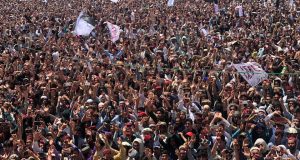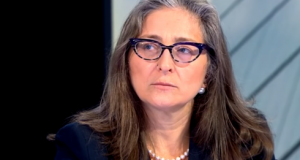 The world is witnessing an epoch making rise of a robust civil rights and Pakhtun Nationalist movement from the north western parts of Pakistan. More and more people, especially the middle class youth, increasingly associate themselves beyond tribal, regional, partisan, gender and class identities with the narrative of this loosely organised and inclusive uprising that calls itself The Pakhtun Tahaffuz Movement (PTM) and that the youth commonly calls The Pakhtun Long March. Two factors might be observed as the motivating forces behind the rise of this movement.
The world is witnessing an epoch making rise of a robust civil rights and Pakhtun Nationalist movement from the north western parts of Pakistan. More and more people, especially the middle class youth, increasingly associate themselves beyond tribal, regional, partisan, gender and class identities with the narrative of this loosely organised and inclusive uprising that calls itself The Pakhtun Tahaffuz Movement (PTM) and that the youth commonly calls The Pakhtun Long March. Two factors might be observed as the motivating forces behind the rise of this movement.
The first and major factor is the accumulated collective agonies of a whole population—the Pakhtuns. At the bottom of the simple human rights based demands—bringing the police officer, Rao Anwar, who is suspected to be involved in Naqeebullah Mehsud extra judicial killing in Karachi, to justice, formation of judicial commission for probing extrajudicial killings, competent investigation of enforced disappearances, de-mining of Federally Administered Tribal Areas (FATA) and stopping of humiliation on the widespread military checkpoints—lie the decades old collective anguish arising out of state policies that perpetrated violent extremism and war economy.
The indigenous and natural resources of the Pakhtuns were depleted through making the whole Pakhtun belt as war zone. The state, non-state, regional and international powers made the Pakhtun belt as a battleground that sprang up private militias, suicide attacks, bomb blasts, abductions, narcotics, gun running and car lifting as various components of economy. Schools, colleges, universities, hospitals, markets and community centres were attacked. Besides thousands of common Pakhtuns, hundreds of social elders were killed over the past two decades.
Large scale displacement uprooted millions of people from different areas of the Pakhtun belt. The ensuing humiliation suffered by the victims at the hands of state and non-state actors of this insane war made the whole Pakhtun community feel worthless.
With the economy of war and violent extremist paradigm comes political disempowerment. The articles on Fundamental Rights enshrined in the constitution of Pakistan were trampled through skewed interpretations and a whole part of the Pakhtun belt., FATA, was retained under the draconian black law of Frontier Crimes Regulation (FCR) for almost 15 decades. The federal democratic guarantees given in the constitution of Pakistan that provide a little space to ethno-national minorities in political decision making are continuously mutilated. The intent of state institutions to roll back the 18th Amendment is a case in point.
It is natural that the young activists of the existing organised political parties find a strong appeal with the additional component of the middle class youth leadership of the PTM. Perhaps Malala Yousafzai and Mashal Khan (and his father, Iqbal Lala) constitute the same young middle class Pashtun leadership who stand for the same narrative
The backbone of the genuine Pakhtun nationalist political parties was broken through the demolition squad of violent extremist private militias. Hundreds of hard core activists of Awami National Party (ANP) were target killed over the past two decades. The political parties that had roots among the people were discredited through a baseless propaganda of ‘corruption’. Test tube politicians and test tube parties were thrust upon the Pakhtun belt. Patronage politics was encouraged and given space.
Pakhtun culture was distorted through the construction of an enforced homogenised and violent extremist narrative. Widespread racial profiling of the Pakhtuns were observed in mainstream media and in academic syllabi.
The second factor that might have motivated the movement is the existence of the Pakhtun Nationalist narrative and both parliamentary and resistance struggle that might be defined through the fundamental human rights framework and federal democratic dispensation. Right from the Roshanite Movement of Bayazid Ansari in the 16th century till the continuation of the Khudai Khidmatgaar Movement of Bacha Khan till the present times, the PTM might have extracted wisdom from both resistance and parliamentary struggle of the Pakhtuns for politico-economic empowerment. Hence, the PTM/Pakhtun Long March seems to be the continuation of the existing narrative and struggle not an aberration. It doesn’t seem to be an alternative but another complementary milestone in the Pakhtun Nationalist struggle.
It is natural that the young activists of the existing organised political parties find a strong appeal with the additional component of the middle class youth leadership of the PTM. Perhaps Malala Yousafzai and Mashal Khan (and his father, Iqbal Lala) constitute the same young middle class Pakhtun leadership who stand for the same narrative.
The existing organised Pakhtun Nationalist parties successfully kept the enlightened nationalist narrative alive and exposed the suicidal state policies that created violent extremism and war economy in the Pakhtun belt. The organised Pakhtun Nationalist political parties also succeeded in making the federal parliamentary democracy as an agreed upon principle through parliamentary struggle.
The PTM was able to tell the stories of collective agony and unbearable anguish. It was able to break through the thick fog of fear and present the human losses and humiliation in a language understood by all those who suffered them. The simplicity and sincerity of the style and diction with which the stories were told by PTM activists in public made thousands of hearts beat with the same tune. The PTM, in fact, retold the narrative of fundamental human rights and right to life of a whole population of the Pakhtuns. It reconstructed the history of Pakhtun nationhood.
The PTM inspired other marginalised nations, ethnicities, groups and classes in Pakistan because of its paradigm of absolute non-violence, agreed upon human values, constitutional framework and counter violent extremism. It is, therefore, fast becoming a civil rights movement in Pakistan.
Unfortunately, instead of listening to the stories of collective agony with compassion, the state institutions have started framing the movement as a ‘foreign sponsored agenda’. The state seems to have sworn to itself not learn from history and use the same outdated and distorted tactics. The state institutions seem to be making argument against themselves. Is the majority of the Pakhtun youth working on a ‘foreign sponsored agenda’?
Both the non-violent resistance struggle and organised parliamentary politics must reinforce and complement each other if the dream of a peaceful, forward looking and prosperous Pakhtun society has to come true. Both paradigms are important for the achievement of cultural, social, economic and political rights of the Pakhtuns. It is, therefore, necessary that undue comparisons are avoided between the two paradigms. Activists of both paradigms must desist from reacting to minor provocations. Affiliates of both paradigms must not allow under any circumstances any violent attitude. Both must be aware of the elements that might have the proclivity to damage the other platform by using their platform.
Historical consciousness informs us that marginalised nations of Pakistan have to either go towards renaissance or plunge into the abyss of darkness in the present era. Decisions must be made on the basis of historical consciousness not personal whims and wishes.
The writer is a political analyst based in Peshawar. He can be reached atkhadimhussain565@gmail.com. Twitter: khadimhussain4
 Pashtun Times Latest News
Pashtun Times Latest News



